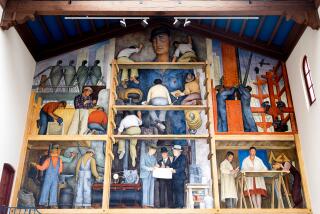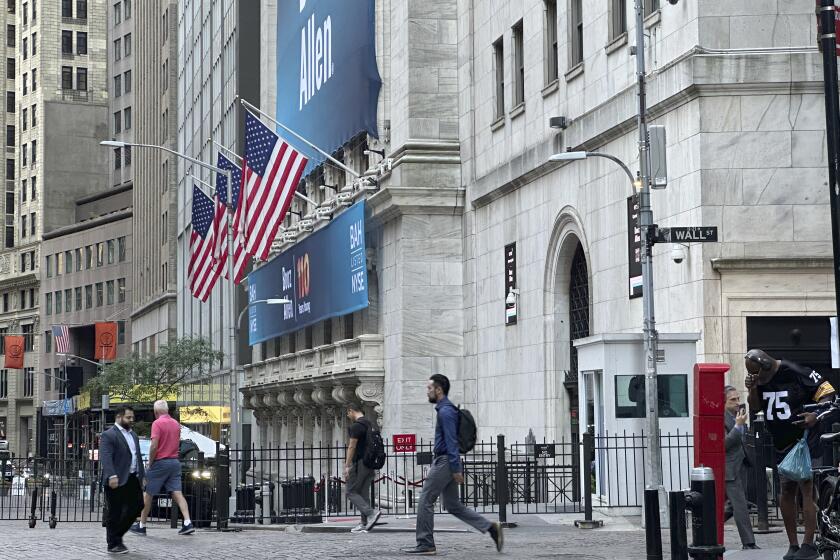Pollock painting to get the Getty touch
- Share via
An important Jackson Pollock painting owned by the University of Iowa that Republican state legislators have lobbied to sell is now leaving the state -- temporarily.
Next month the massive 1943 oil painting called “Mural” is traveling to the Getty Center, where it will be the subject of an extensive conservation effort expected to last 18 months.
Pollock painted the canvas, which measures roughly 8 feet tall by 20 feet long, as a commission for collector Peggy Guggenheim a few years before he began his so-called drip paintings, his most famous work. But “Mural” sets the stage for this breakthrough, both because of its loose, loopy brushwork and its shift from symbolic to abstract forms.
Although nobody knows the exact market value of the work, given to the university in 1959, it is now insured for $140 million. Legislators looking at the painting have seen dollar signs. Last year, Republican state Rep. Scott Raecker introduced a bill to force the sale of the artwork, but it sparked considerable controversy and was quickly withdrawn.
Getty head James Cuno said that politics played no role in the decision to take on the painting.
“For us it’s an opportunity to preserve an incredibly important work of art,” he said. “It’s an idiosyncratic painting but very important in the development of Pollock’s work. It’s a hinge painting in his career, from his early calligraphic paintings to his drip paintings.”
Two Getty branches, the museum and conservation group, have teamed up to work on the painting together. The head of paintings conservation for the museum, Yvonne Szafran, named three goals for their work. One is to address the sagging of the canvas at the center caused by its weight and size. Another is to replace or reinforce the stretcher. A third goal, if possible, is to remove the varnish that was added after Pollock’s lifetime.
“It wouldn’t be a dramatic change -- it’s not that the varnish has yellowed dramatically, but it’s like a veil sitting on the surface of the painting that he did not intend,” Szafran said.
In addition, she said the Getty would be doing “a lot of looking and analyzing and imaging -- with X-rays and infrared work” to learn more about the artist’s techniques and materials. For instance, did he use house paint in addition to oil?
During this process, Cuno added, scientists will not be the only people able to see the work. Outside scholars and artists alike will be invited to examine it and share their insights.
Once conservation is complete, most likely in spring 2014, the Getty plans to display the painting for three months, an arrangement it has made before when conserving artwork from other institutions. A publication on the conservation process will accompany the work’s ex- hibition.
The painting is currently on view at the Figge Art Museum in Davenport, Iowa, while the University of Iowa is preparing to raise money for a new museum building to replace one damaged by the 2008 flood. Sean O’Harrow, the university museum director (who was previously director of the Figge), said the lack of a permanent home for the Pollock did play a role in deciding to do the conservation now.
“We didn’t have to remove the painting from a permanent exhibition,” he said. “The timing couldn’t be better.”
The persistent calls for the school to sell the Pollock include an op-ed by longtime Iowa journalist and former NBC News President Michael Gartner that appeared this month in the Iowa weekly Cityview. He argued that the sale was a way to “supply free undergraduate tuition, annually and forever, to ... 1,000 needy Iowans.”
O’Harrow and university President Sally Mason have both taken strong stands against such arguments, saying the thinking is short-sighted and that the painting is irreplaceable. They also maintain that a sale would be a violation of the donor’s intent.
So was the Getty conservation partnership a convenient way of keeping the painting out of the hands of the parties who seek to liquidate it? O’Harrow said that that was not a consideration, but calling attention to the work’s significance was.
“Raising awareness of the work’s importance is definitely part of our plans,” O’Harrow said. “The more people know about the work and value it as a national treasure, the less likely it is to be hocked for short-term gain somewhere.”
--
More to Read
The biggest entertainment stories
Get our big stories about Hollywood, film, television, music, arts, culture and more right in your inbox as soon as they publish.
You may occasionally receive promotional content from the Los Angeles Times.










